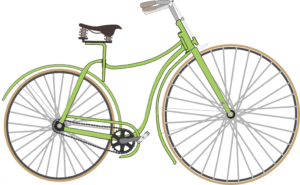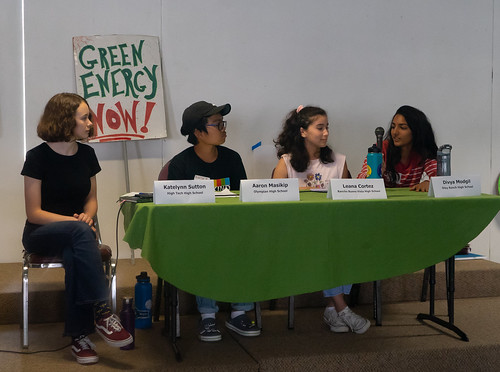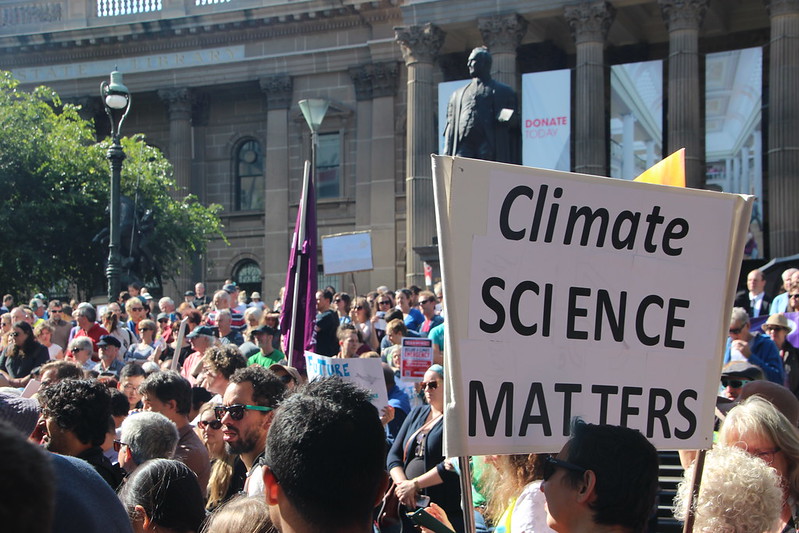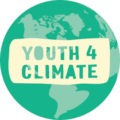7. Find Your Voice
What’s Your Story?

Activity #7A:
What’s Your Story?
1. Pick three or four questions from the list below and jot down some answers:
- I first learned about climate change when…
- Climate change has personally affected me or someone I’m close to by (describe in what way: sea level rise, flooding, drought, fire, etc.)…
- I’m passionate about taking action on the climate by…
- I learned about Climate change and what it means for my future when…
- An action I’ve taken on climate that I have found to be personally empowering…
- What other actions could I see doing for climate?
2. Pair-up with someone and share your responses to the above questions.
POWER OF YOUR VOICE: USE IT!

Get the Word Out…Often!
Have face-to-face conversations: Think about who you can influence most: parents, family, teachers, other adults in your life, friends, peers, family, community members, congregation members. Tell them your climate story.
Your delivery: Learn by doing: get experience by telling your story. The more you do it, the better you’ll get, but you just need to jump in there and start talking.
Keep passion alive: If your conversations become stale or boring to you, imagine how the other person will feel.
Tell People it’s Urgent to Take Action
Given the urgency of addressing the climate crisis: Let people know that their involvement matters… we can make a difference by working together.
STAY GROUNDED IN BASIC SCIENCE

Climate Science Tells Us: We Must Act!
To decrease global emissions rates, we need a global commitment to shift from fossil fuels to clean energy. We must demand it for governments to take big action.
Scientific Research Shows:
Warming must be limited to 1.5°C to prevent the more severe effects of climate change.
To stay within the 1.5°C limit, CO2 emissions need to fall by about 45% by 2030 and be at net zero by 2050.
Extreme events such as floods and droughts will increase 50% with every half degree of warming.
Effects of climate change already impact our health: heat related deaths, worsened air quality, reduced access to safe food and water, wildfire, drought, and increased risk of vector borne disease.
If we reach certain tipping points, there’s no going back.
We Have the Solutions
We have all the tools, technology, and scientific ability to implement climate solutions right now!
- Tell them to talk to everyone they know about the crisis.
- Invite them to get involved with climate action campaigns… individual actions are necessary but aren’t enough by themselves.
- Vote, if they can!
We Can Win… Together!
- We are capable of standing together on this issue.
- Climate solutions address many of our shared values: jobs, health, transportation, equality, and political stability.
- Look to history: the world has successfully enacted important cultural shifts in the past: Abolitionist Movement, Women’s Suffrage Movement, Berlin Wall coming down.
- We can work together and solve the climate issue!
Convey Balanced Optimism
Most people feel helpless in the face of such a large challenge. Give people HOPE and something meaningful they can do!
Use emotionally powerful imagery to engage people.
Studies show high school students are more likely to engage in pro-environmental behavior if they are hopeful about climate change solutions.
When People Ask, ”What Can I Do?”
MOVE PEOPLE INTO ACTION: It’s time to shake people free from complacency and move them into action!
- Tell them to talk to everyone they know about the crisis.
- Invite them to get involved with climate action campaigns… individual actions are necessary but aren’t enough by themselves.
- Vote, if they can!
CLIMATE CHANGE TALKING POINTS
We have the power to influence our peers to take action on climate change. Discuss it in your everyday conversations:
- Lead by example: Tell people what you have been doing that relates to the climate crisis.
- When someone asks, “What have you been up to lately?” Tell them:
- “I’ve been spending a lot of time learning about the climate crisis.”
- “I’ve been attending rallies for the climate crisis.”
- “I recently followed this amazing climate activist on Instagram—check them out!”
- Post about the issue on social media, share videos and songs with people, etc.
- Listen to others and show you care—talk about the issue as something that means a lot to you.

Show you are knowledgeable, truthful, credible (walk your talk), and caring (listen to others).

Activity #7A:
Tell Your Story
Step #1: Talk to 3 people about the Climate Crisis this week
Try to make at least ONE of the conversations a bit deeper. Take some notes and be ready to share how it went. Ideally, choose three different types of people (friend, parent, teacher).
Step #2: Develop Your Story
I was first exposed to climate change and learned what it meant for my future… when:
__________________________________________________
I felt empowered when I took action… by: ________________________
Step # 3: Include Basic Facts
To lower emissions, we need to demand a clean energy future! If we reach certain tipping points, there’s no going back, and we will be facing climate chaos. Here’s what that looks like in our region…
Step # 4: Empower People
We can change, we already know what we need to do and have the tools to do it. We need to work together to solve the climate crisis—together, we can do it!
Step # 5: Be Specific
Tell them here’s how they can help:___________________
Step #6: Get a Commitment (advanced move)
Ask them: Can I count on you to…?
Meet:
Elea Castiglione
San Diego High School, San Diego, CA
Class of 2022

HOT TIP:
“Stay on message! Resist pushback that seeks to distract from your passion and goals.”
WHAT I’VE LEARNED:
Communicate with your administrators a few weeks prior to the walk-out, (rather than the week of).
Elea is a climate and civil rights activist with an interest in international relations as a career. She hopes to continue working towards climate justice throughout high school and beyond.
Activities: Public speaking, organizing events, outreach to students & community members, and motivating teens to take action.
Highlights: “Process of planning the youth climate walkout was an amazing experience. I learned a lot from speaking to the school board, interacting with participants, and communicating with news agencies. My favorite part was the open mic where we heard stories from students and other advocates about why they chose to walk out.”
Quick Guide #7
HOW TO TALK ABOUT CLIMATE CHANGE
-
PERSONALIZE:
Develop a compelling story of why you’re engaged in climate action. Frame climate change as personal to those you’re speaking to: show how it’s affecting them NOW.
-
YOU HAVE POWER OVER PEOPLE IN YOUR LIFE, USE IT!
Think about who you can influence: people who share your values and experiences. What motivates them?
What matters to them? Ask: have you been personally affected by climate change?
For Example: Most students are concerned with social justice issues, health issues, and the moral responsibility of creating a sustainable world. They are not much interested in saving money. However, economics is a key a consideration for older people, and many climate solutions do save money. -
CREATE A DIALOGUE WITH YOUR AUDIENCE:
Listen to their concerns. Let them know you heard them. Avoid being preachy or coercive. Be open to discussion.
-
FOCUS ON:
Educating and motivating your parents and friends to take action.
-
LET YOUR PASSION SHINE:
Bring passion to your message. Hold people’s attention, be concise, get to the crux of the matter quickly, and make it interesting. Use captivating visuals, stories, narrative, and other creative forms of engagement to build sense of optimism about tackling climate change.





